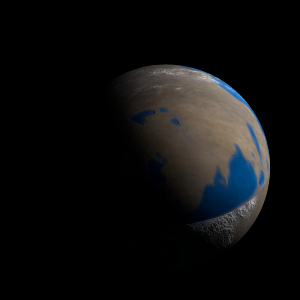|
|
Space Astro
|
Info for exoplanet "Porara-nya"
| Scientific (actual) data |
|---|
| Name | Kepler-1259 b |
| Planet status | Confirmed |
| Radius | 0.128 |
| Orbital period | 0.663085 |
| Discovered | 2016 |
| Updated | 2021-02-05 |
| Tconj | 2454960 |
| Publication | Announced on a website |
| Detection type | Primary Transit |
| Alternate names | 2MASS J19512195+4658036 b, K02493.01, KIC 10028535 b, KOI-2493 b, KOI-2493.01, WISE J195121.90+465803.7 b |
| Star name | Kepler-1259 |
| Right ascension | 297.84° |
| Declination | 46.97° |
| Mag j | 13.872 |
| Mag h | 13.339 |
| Mag k | 13.28 |
| Star distance | 704 |
| Star metallicity | -0.07 |
| Star mass | 0.8 |
| Star radius | 0.77 |
| Star age | 5.25 |
| Star temperature | 5053 |
| Star alternate names | 2MASS J19512195+4658036, KIC 10028535, KOI-2493, WISE J195121.90+465803.7 |
| Wikipedia article | Kepler-1259 b |
Back
| |
| Fictional info (?) |
|---|
| Suggested name | Porara-nya |
| Planet type | Cold planet |
|
| Atmosphere | Carbon monoxide | 98% |
| Hydrogen | 1.4% |
| Nitric oxide | 0.044% |
| Hydrogen chloride | 0.007% |
| Atmospheric pressure | 90 bar |
 |
| No known satellites |
| Google search for Porara-nya |
|
Website by Joachim Michaelis
|
|
|
|